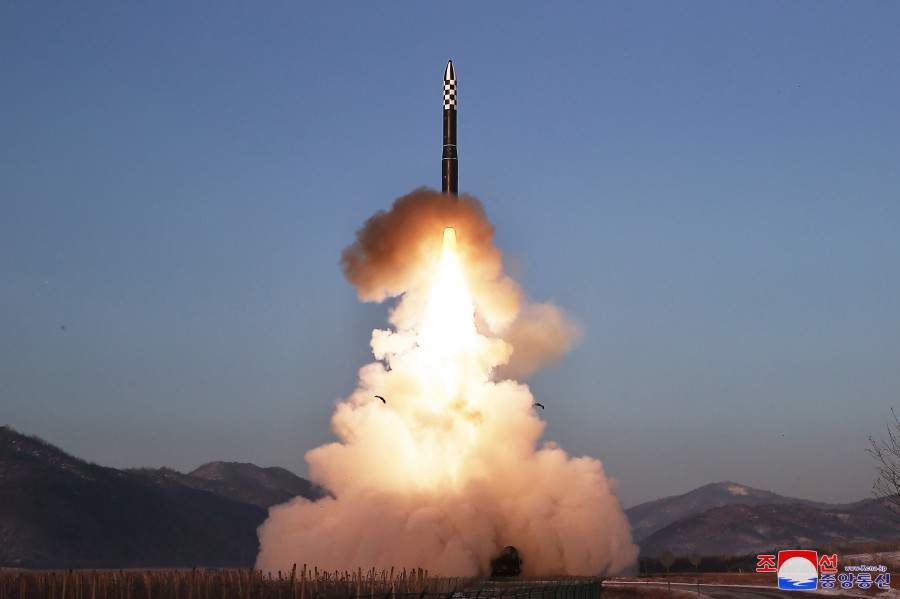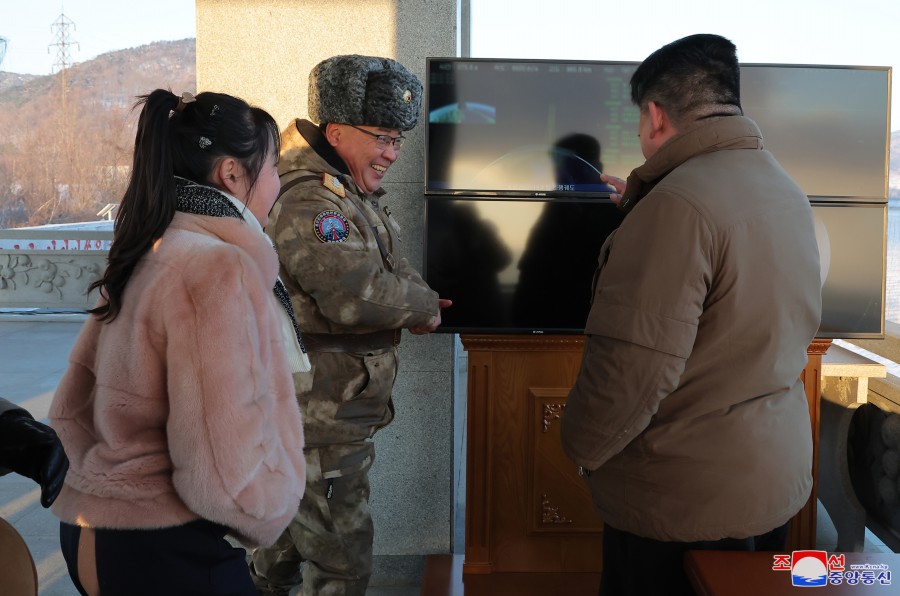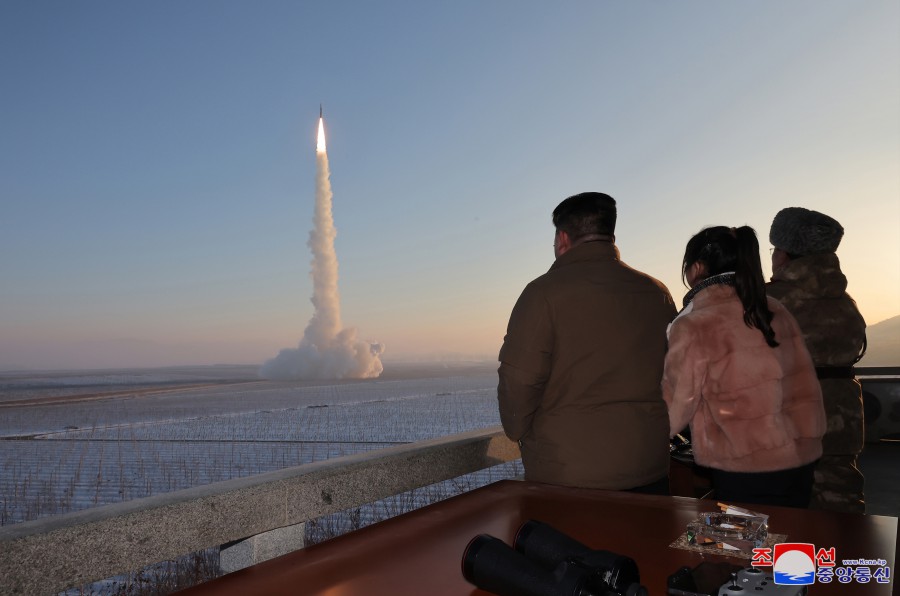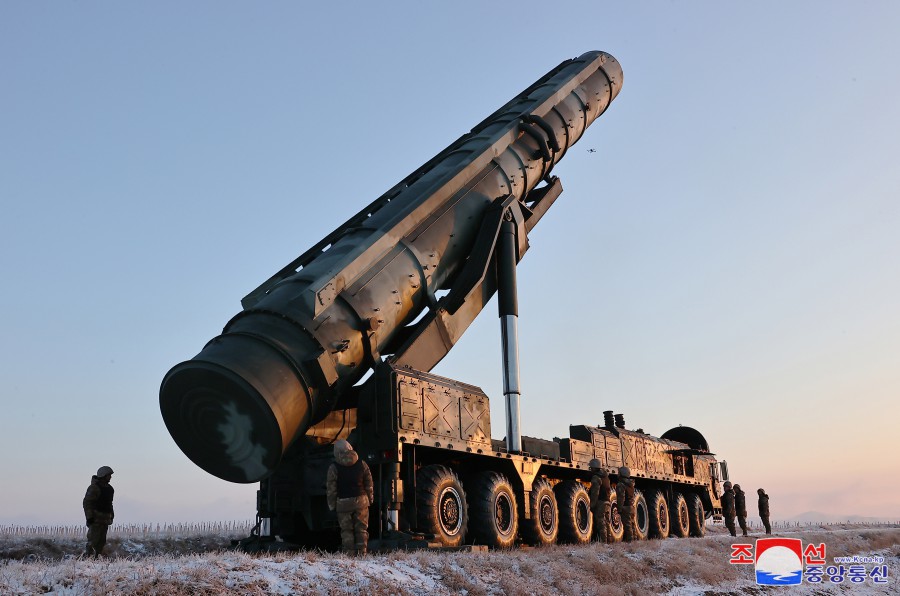Third Successful Launch of North Korea’s Hwasong-18 Solid ICBM Probably Marks Operational Deployment
North Korea launched a Hwasong (HS)-18 solid-propellant, road-mobile intercontinental ballistic missile (ICBM) on December 18. This was the third launch of the system and the third success, thus continuing Pyongyang’s remarkable track record of successful solid-propellant missile launches. The North’s characterization of the event as the “launching drill of an ICBM unit” indicates that Pyongyang now regards the HS-18 ICBM system as operationally deployed. Deployment after so few launches is unusual for other missile-faring nations, but is quite typical for North Korea.
The HS-18 joins two liquid-propellant ICBMs. The HS-15 has probably been deployed since its initial flight test in November 2017, and the large HS-17 has probably been deployed since its use in the “launching drill” of an “ICBM unit” in March 2023. It remains unclear why North Korea has decided to field three different types of ICBM, although the HS-17 will be able to carry heavier and larger-diameter payloads, such as the “multi-warhead rockets” and “super-large hydrogen bombs” North Korea claims to be pursuing.
Compared to the liquid ICBMs, the solid-propellant HS-18 will be easier and safer to operate in the field; it will need fewer support vehicles, and so should be easier to conceal (and thus somewhat safer from attack); and it has the potential to be more reliable. But Gulf War experience indicates that camouflaged liquid ICBMs are likely to be highly survivable in the field, and North Korea has some 35 years’ experience in field deployments of liquid missiles.
The HS-18 will add to the overall size of the North Korean ICBM force, but it will probably augment, not replace, the two liquid ICBM types. How big Pyongyang’s ICBM force is, and will become, and how much of it will be composed of HS-18s, all remain to be seen.
The Launch
On December 18, North Korea launched an ICBM from the Pyongyang area, according to the Japanese and South Korean governments. The apparently successful flight was estimated to have taken about 73 minutes, with a maximum altitude of over 6,000 kilometers (km) and a range of about 1,000 km (a highly lofted trajectory), impacting to the northeast in the East Sea/Sea of Japan. The next day, North Korean media reported the launch of an HS-18 ICBM with a maximum altitude of 6,518.2 km, and essentially the same range and flight time reported by Japan. The North characterized the event as “the launching drill of an ICBM unit,” which it said was conducted as a “powerful warning measure” against “the hostile forces’ anti-DPRK military threat” in order to “clearly show the DPRK’s nuclear strategic forces’ overwhelming counteraction will and matchless strength to the enemies.”


Implications for the HS-18 Program
This was the third launch of the HS-18 (the two previous being on April 13 and July 12 of this year) and the third consecutive success. North Korea thus continues its remarkable track record of successful boost-phase operation of solid-propellant ballistic missiles. The reported trajectory was very similar to the July launch, which North Korea suggested exhibited the HS-18’s “maximum range”—which would amount to some 15,000 km on a non-lofted, operational trajectory, enough to reach anywhere in the continental United States, depending on the missile’s payload weight. North Korean photos and videos do not indicate any structural changes in the missile have been made since the previous two launches. The latest launch also occurred from a road some distance away from the concrete pad used in the two previous launches, underscoring earlier indications that the HS-18 has sufficient off-road mobility to allow adequate survivability.
The North’s use of the phrase “launching drill of an ICBM unit” indicates that Pyongyang now regards the HS-18 ICBM system as operationally deployed. This suggests that the first two tests were developmental, and the latest launch is an acceptance or unit certification test. Deployment of the system eight months after its first flight test and after just two developmental flight tests is unusual for other missile-faring nations, but it is quite characteristic of North Korean missile development practices. Indeed, 38 North’s coverage of the first HS-18 launch expected deployment after one or two more tests.
There is no open-source information on how many HS-18 missiles may currently exist. Five road-mobile HS-18 launchers have been seen in photographs released by North Korea, but we do not know if there are any others. The production rate for HS-18 missiles or launchers, and how many HS-18s North Korea might ultimately deploy, also are unknown.
Another factor complicating future HS-18 production and deployment is North Korea’s November 2023 announcement of work on a new, solid-propellant intermediate-range ballistic missile (IRBM) apparently based on the HS-18, including two ground (static) tests of the IRBM’s two booster stages. Production of the motors for the new IRBM will presumably come at the expense of using essentially the same motors in HS-18 production. An IRBM version of the HS-18 was suggested in 38 North this April, and the later spinning off of an IRBM from an earlier solid ICBM is what the Soviets did in creating the later SS-20 solid-propellant road-mobile IRBM by using two stages of the earlier SS-16 ICBM.


Implications for the ICBM Force
The solid-propellant HS-18 joins two other types of road-mobile ICBMs, both liquid-propellant, that North Korea probably has previously deployed:
- The HS-15 probably has been deployed since its initial flight test in November 2017. A launch in November 2022 failed during second-stage operation.[1] Its most recent launch, this February 18 (a success), was characterized by North Korea as a “launching drill… suddenly organized without previous notice under an emergency firepower combat standby instruction”—further suggesting the HS-15 is deployed. It is unclear how many HS-15s are currently deployed or how many will be produced and deployed in the future.
- The large, liquid-propellant HS-17 probably has been deployed since March 2023, when it was successfully launched in what North Korea termed a “launching drill” of an “ICBM unit.” Prior to that time, the HS-17 had been flight tested once (unsuccessfully)—and probably twice (successfully)—in March 2022 and successfully again in November 2022.[2] It is unclear how many HS-17s have been deployed, although 12 of its road-mobile launchers were seen during a February 2023 parade in Pyongyang. As with the other ICBM systems, how many will be deployed in the future is unknown.
It remains unclear why North Korea has decided to field three different types of ICBM.
- The larger HS-17, more difficult to move around than the other two types, would seem to have as its comparative advantage its ability to carry heavier and larger-diameter payloads, such as the “multi-warhead rockets” and “super-large hydrogen bombs” North Korea claims to be pursuing.
- Because of its use of solid propellants, the HS-18 will be easier and safer to operate in a road-mobile mode than liquids; it will need fewer support vehicles, and so should be easier to conceal in the field (and thus somewhat safer from attack); and it has the potential to be more reliable than liquid missiles.
- But the HS-15 probably weighs less than the HS-18, and thus would be at least as easy physically to move around. Gulf War experience indicates that camouflaged liquid-propellant ICBMs are likely to be highly survivable in the field, and North Korea has some 35 years’ experience in field deployments of liquid missiles.
The HS-18 will add to the overall size of the North Korean ICBM force, but based on the available information, it appears that the solid-propellant missile will augment, not replace, the two liquid ICBM types. How big Pyongyang’s ICBM force is, and will become, and how much of it will be composed of HS-18s, all remain to be seen.
- [1]
A successful ICBM launch on March 24, 2022, claimed by North Korea to be an HS-17, was claimed by South Korea actually to be an HS-15. This author assesses it was probably an HS-17. See Vann H. Van Diepen, “North Korea’s March 24 ICBM Launch: What if It Was the Hwasong-17?,” 38 North, April 7, 2022, https://www.38north.org/2022/04/north-koreas-march-24-icbm-launch-what-if-it-was-the-hwasong-17; Vann H. Van Diepen, “Revisiting the Hwasong-17/15 Controversy: What if North Korea Had Launched a Hwasong-15?,” 38 North, April 27, 2022, https://www.38north.org/2022/04/revisiting-the-hwasong-17-15-controversy-what-if-north-korea-had-launched-a-hwasong-15; and Vann H. Van Diepen, “North Korea Showcases Two Types of ICBMs In November 2022 Tests,” 38 North, December 2, 2022, https://www.38north.org/2022/12/north-korea-showcases-two-types-of-icbms-in-november-2022-tests.
- [2]
Vann H. Van Diepen, “North Korea Showcases Two Types of ICBMs In November 2022 Tests,” 38 North, December 2, 2022, https://www.38north.org/2022/12/north-korea-showcases-two-types-of-icbms-in-november-2022-tests. These figures do not include four other tests (three successful) between February and May 2022 using unidentified HS-17 components.
